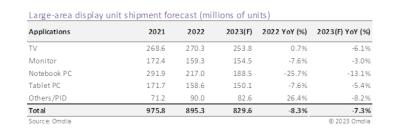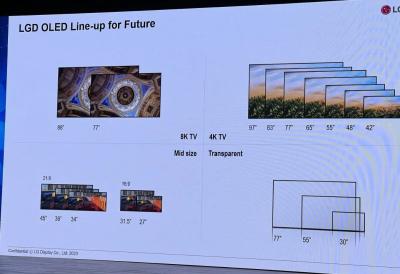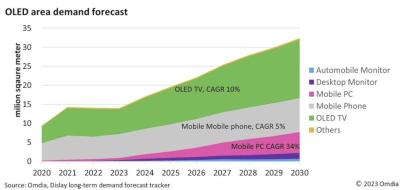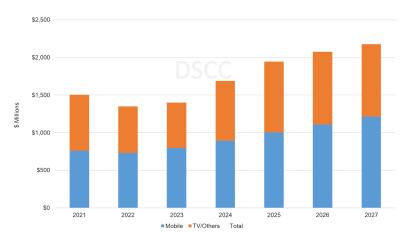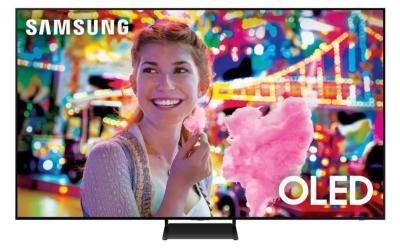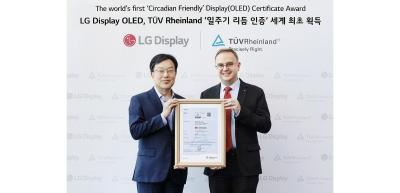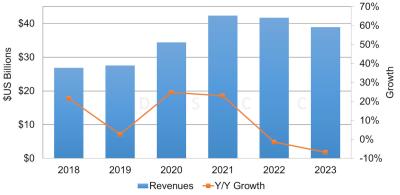OLED TV: Introduction and Industry News - Page 5
Omdia: the global large-area display market to decline over 7% in 2023 by units
Omdia released its latest analysis on the global large-area display market (LCDs and OLEDs combined), saying that it sees a decline in unit shipments of 7.3% from 2022. This is a sharper decline that what Omdia estimated a few months ago, as the demand continues to slide.
Interestingly, looking at the total market by display area, 2023 will see a slight increase (0.5%) over 2022, this is mostly because consumers are buying larger TVs and larger gaming monitors.
LG to soon start producing 32", 34" and 39" WOLED panels
LG Display showed its WOLED roadmap during the K-Display conference in Seoul, saying that it will soon start producing 32-inch (16:9), 34-inch (21:9) and 39-inch (21:9) models. These panels are aimed for computer monitor applications, rather than TVs, although the 32-inch could also be used as a TV panel.
LGD did not detail when it expects to start producing these panels. Dough already unveiled a few weeks ago that it is working on a 32" monitor, and this will be base on an LGD WOLED panel
LG Display demonstrated its 30" and 77" transparent OLED displays for the first time
LG Display is demonstrating its new 30" and 77" transparent OLED displays for the first time, at the company's booth at K-Display 2023, in Seoul, Korea.
Credit: LG Display
The new 30" transparent OLED offers HD resolution, while the 77" panel offers 4K resolution. All of LG's latest transparent OLED displays offer 45% transparency. LG showed its entire range of T-OLED displays in a coffee shop setting, in partnership with Starbucks.
Omdia: the OLED market by area will grow to over 30 million sqm in 2030
Market research firm Omdia says that according to its latest forecast, the OLED market will grow at a CAGR of 11% from 2022 to 2030, by total display production area.
The main OLED application is smartphone displays, and Omdia says that in 2022 the penetration of OLED displays into that market reached 42%. The market share of OLED smartphones will rise steadily in the future. The OLED TV market is experiencing a slowdown, but Omdia says it will resume growth in 2024.
DSCC: the AMOLED material market to resume growth in 2023, to reach $2.18 billion in 2027
DSCC expects the AMOLED stack material market to grow 4% in 2023, to $1.4 billion, and to reach $2.18 billion in 2027, that's a 12% CAGR from 2023 to 2027. In 2022, the market declined by 10%. The forecast does not include any UDC revenues from blue PHOLED materials, which means that if UDC succeeds in commercializing its blue material, revenues could be higher by hundreds of millions of dollars.
DSCC says that demand for OLED TVs will continue to decline in 2023. In 2022, revenues of OLED TV revenues declined by 17%, and in 2023 revenues will decline 3% further. Growth will resume, though, in 2024, and in 2023-2027 the market will grow at a CAGR of 13%.
Samsung officially launches its first OLED TV based on LG's 83" 4K WOLED panels
Samsung officially launched the 83S90C, the company's first TV to use LG's WOLED panels. It uses a 4K 120K 83" OLED display, and is powered by Samsung's AI-powered Neural Quantum Processor. The S83S90C will start shipping in a few days in the US, with a suggested price of $5,400.
Interestingly, Samsung decided to have its first WOLED TV sit in the same range as its QD-OLED TVs, the S90C, which includes 55-, 65- and 77-inch QD-OLED TV panels. It's likely the company will try to blur the differences between the QD-OLED and the WOLED panels, and not discuss too much its reliance on LG Display's supply.
LG's OLED TV and monitor panels are the first to earn the Circadian-Friendly certification from TÜV Rheinland
Independent testing and certification leader TÜV Rheinland has awarded LG's OLED TV and monitor panels with its 'Circadian Friendly' certification. LG's OLEDs are the first displays to ever receive this award.
TÜV Rheinland new 'Circadian Friendly' certification is given to products that meet the standards of minimizing their impact on people's quality of life during the day and promote better sleep at night. These products undergo rigorous testing based on the 'Circadian Stimulus' metric, designed by the Rensselaer Polytechnic Institute's Lighting Research Center.
Samsung Electronics said to order the first WOLED panels from LGD earlier this month
According to recent reports, LG and Samsung finally officially signed a WOLED TV panel supply agreement, as Samsung Electronics plan to start producing OLED TVs based on LGD WOLED panels.
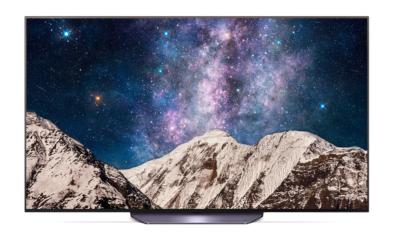
According to recent reports from Korea, Samsung Electronics placed the first order for WOLED panels (77-inch and 83-inch) from LGD earlier this month. This was a small order, used by Samsung to develop the first OLED TV, which Samsung aims to launch later in 2023. It seems the two companies haven't yet finalized all the details of their agreement.
DSCC: OLED panel revenues to decline in 2023, in a second consecutive year
DSCC says that OLED panel revenues will decline 7% in 2023 (to $38.9 billion), the second consecutive year that the OLED market is seeing a decline in sales. The largest declines will be in the OLED TVs and laptops segments.
The OLED smartphone market will actually grow 4% in unit sales, but revenues will decline 5%. The OLED TV market will decline 29% in 2023 in both revenues and units. OLED laptop unit sales will decline by 15%. All other segments, including AR/VR, automotive and tablets, will grow in sales and revenues in 2023.
What can deuterium do for OLED displays?
The following is a sponsored post by Cambridge Isotope Laboratories
OLED has become the display technology of choice for many commercial products such as smartphones, laptops, tablets, TVs, automotive dashboards and wearables. OLED has advantages with improved image quality (better contrast, higher brightness, fuller viewing angle, wider color range, and faster refresh rates), lower power consumption, and simpler designs (ultra-thin, flexible, foldable, and transparent displays).
Cambridge Isotope Laboratories plant in Xenia, OH, USA
OLED, however, faces several technical challenges. While OLED TVs yield better picture quality than common LCDs, they are usually less bright. Research using a compound that has at least one hydrogen replaced with its heavier isotope, deuterium, is showing promise toward achieving greater brightness. Since the bonds between carbon and deuterium are stronger than those between carbon and hydrogen, materials made with deuterated compounds tend to have a longer lifetime, which allows OLED displays to run brighter but still last as long.
Pagination
- Previous page
- Page 5
- Next page
